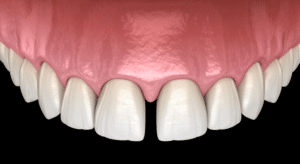
So what is diastema? Diastema refers to a space or gap between teeth. Although these spaces can occur anywhere on the gum line, a diastema is most noticeable when it is in front. If you have a diastema, it could be due to a dental condition. Your dentist would know for sure, and they can offer you treatment options.
Table of Contents
What Causes Diastema?
Some cases of diastema develop due to average tooth growth. In childhood, gaps can develop between the front teeth, especially in children aged 6-8. By the time the upper canines form, gaps close in most children. Besides typical tooth development, tooth position, shape, or size can cause spaces to appear. For example, front teeth can drift apart if the canines are not in a healthy position.
Some cases of diastema are genetic. Having teeth that are small relative to their jawbone can contribute to tooth gaps. This tendency often runs in families.
Diastema has several other causes, such as gum disease or periodontitis, which can damage the tissue supporting your teeth. Obstructions like extra teeth or cysts can also leave unnatural spaces. For some people, the placement of their tongues can create gaps, especially when their tongues exert excess pressure against the front teeth. Tongue pressure can also come from an unhealthy swallowing reflex.
Some habits can create gaps or make them more pronounced, like thumb sucking or biting your lower lip. People with tongue piercings need to be careful not to press the stud against or between their front teeth, which could push them apart.
How is Diastema Treated?

A tooth gap is not necessarily a problem for some people who think it adds to their smile and appearance. While some diastema cases cannot be prevented, there are several ways to treat mild or more severe forms of this condition.
In children, diastema sometimes resolves itself as teeth continue to develop. A dentist can tell you for sure whether your child’s tooth spacing is natural or if it needs correction. Gaps two millimeters or less are likely to close independently, especially as permanent teeth become predominant.
Gum disease is a common cause of diastema. If this applies to you, your dentist will likely focus on getting this condition under control, correcting some of the gap. Your dentist might prescribe topical or oral antibiotics to treat minor gum disease if you have a bacterial infection. Other options include scaling, which involves bacteria removal, and root planing or smoothing the tooth root.
If the gum disease is more severe, then surgery may be necessary. Surgical remedies for advanced gum disease include bone grafting, flat surgery, guided tissue regeneration, soft tissue grafts, and tissue-stimulating proteins. The cost of periodontal surgery varies widely, with patients paying between $500-$10,000, depending on the procedure and severity of the gum disease.
For diastema not caused by gum disease, your dentist can recommend many remedies. For instance, many people get braces, which can cost several thousand dollars. The dentist might use traditional wires and brackets or recommend invisible braces. Braces might not be a permanent solution if the teeth are likely to drift apart without being held in place. In these cases, patients might need a permanent retainer.
Prostheses like removable implants or crowns can help reduce tooth gaps that result from missing teeth. Patients might pay up to $2,000 per tooth, depending on the type of prosthetic they get.
Minimally invasive procedures like veneer placement or composite bonding can close the gap in front teeth and provide a more pleasing appearance. Porcelain veneers can also correct diastema while being minimally invasive. Veneers can cost $1500-$4000 per tooth and may involve permanent alteration of the tooth enamel (except Micro-Thin Veneers). With composite bonding, the dentist applies composite material to the teeth and shapes them into a natural look, extending their width. Composite bonding typically costs $600-$1,500 per tooth. Composite bonding or porcelain veneers both have there pros and cons, you should discuss those with your dentist. If considering composite bonding, be sure your dentist is trained with the Bioclear technique.
The time it takes to close a gap in front teeth depends on the severity of the diastema and the patient’s treatment. With milder cases, invisible braces can correct the problem in six months. More serious gaps might require up to 18 months for a remedy to achieve results. Some cases require a combination of orthodontics and composite bonding or porcelain veneers.
Prevention of Diastema
You might be able to prevent some forms of diastema, which often come from unhealthy oral habits. For example, if you have a young child, help them break habits like sucking their thumb. Adults can also engage in bad habits like biting or chewing their lower lips. Ceasing this behavior can help maintain good teeth aligning and spacing.
Good oral hygiene can prevent many dental problems, including diastema. Be sure to brush your teeth thoroughly at least twice daily, and floss once a day. Regular dental checkups can help you keep your teeth clean and allow your dentist to check for and monitor tooth gaps.
- Dental Implant Pros and Cons - August 26, 2023
- Receding Gums Stages - August 12, 2023
- When Is It Too Late for Gum Grafting? - July 8, 2023


